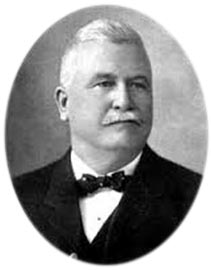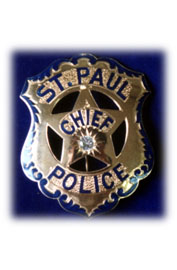John Joseph O'Connor and the "Layover Agreement"
(One Person's Observations)
by Edward J. "Ed" Steenberg
Saint Paul Police Historical Society

|

|
|||
|
As a retired Saint Paul police supervisor, some may feel that I am biased in favor of John J. O'Connor. But, to the extent possible, I have attempted to give an accurate portrayal of the events taking place during this era through period documents. ejs |
||||
Genealogical records indicate that John J. O'Connor (1855-1924), son of John O'Connor1 (1826-1883) and Catherine Woulfe (1831-1899), was born on Monday, October 29, 1855 in Louisville, Jefferson County, Kentucky. He died of natural causes on Thursday, July 3, 1924 in Los Angeles County, California, at the age of sixty-nine. John J. moved with his Irish born parents to Saint Paul in 1856 where they owned and ran a Robert Street boarding house. John's father was also a Saint Paul patrolman for a short period of time, having been appointed on or about April 21, 1863 and resigning some time prior to 1874. John J. O'Connor had two Saint Paul born younger brothers, Richard T. O'Connor2 (1857-1930), a career Democratic politician, and Daniel J. O'Connor3 (1860-1895), a Saint Paul police detective. John J. O'Connor married Annie B. Murphy on January 24, 1890, but that relationship ended in 1922.
In the Sunday Morning, February 16, 1896 issue of The Saint Paul Daily Globe, in an article titled "The Police of St. Paul,"4 reporter C.J.W. writes that "John J. O'Connor, chief of detectives, is a Kentuckian by birth, but only missed being a native St. Paul boy by one year. He came to this city with his parents in 1856 and was engaged in mercantile pursuits during his young manhood. On March 9, 1881, he was appointed to the police force in the capacity of detective, and a few years later was made chief of that branch of the service. Chief O'Connor has a special adaptation for his work and is counted by competent judges as among the shrewdest and best detectives in the country. Under his guidance the work of the secret service department has been very thorough and efficient."
The same Daily Globe article states that in 1896 "... over its twenty-eight lines of railway 400 trains arrive and depart daily, carrying hundreds of tons of freight and thousands of passengers." A uniformed patrolman and a "brace" of detectives were reported to having been assigned to the Union Depot, where the "trains roll in hour after hour throughout the twenty-four and the passengers pass in hurried crowds to and from the way gates." From a gallery of rogues' pictures at Central Station, miscreants were identified by O'Connor's detectives and put on the next train out of town. Nothing was mentioned about a layover agreement.
A biography of John J. O'Connor in a 1919 publication of the Saint Paul Police Benevolent Association5 describes him as a "highly efficient" chief, whose father was one of the pioneers and early business men of the city and served as a member of the city council for several years. It was during John's period as chief of detectives and later as chief of police that he put into practice what he called a policy of opposing "organized crime with organized intelligence." The biography goes on to say that he became known all over the country as one of the "shrewdest living detectives," and professional crooks gave Saint Paul a wide berth. Again, nothing was mentioned about a layover agreement.
But John J. O'Connor's grand scheme for a model police system based on organized intelligence appears to have taken a wrong turn and down a slippery slope, for although during the eighteen years when O'Connor was chief of police he established a system for monitoring the activities of "known crooks," the arrangement developed into an understanding that allowed criminals safe travels within the city of Saint Paul, as long as they committed no major offenses therein. This understanding became known as the "O'Connor Layover Agreement." And, although I did not find that any hard evidence exists that John J. O'Connor personally benefited from the layover agreement in a financial way, there is plenty of anecdotal evidence that suggests that he did. There is also sketchy speculation that O'Connor's wife, Annie, was a madam working out of the notorious Bucket of Blood Saloon, one of Saint Paul's well known Washington Street bordellos. It is reported that about the time when John. J. O'Connor was appointed detective, the city had seven brothels (some estimates say it was at least a dozen6) and 242 saloons, while Minneapolis, which had 5,000 more residents, claimed only four houses of prostitution and 176 saloons.7 Upper levee dives and groggeries, dance halls, gambling dens and gaming rooms flourished.
Records indicate that many Saint Paul residents lauded O'Connor's early policies, feeling that they afforded them a safer place to live and work, at least in the beginning. In 1904 The Saint Paul Globe8 praised the O'Connor system and the police force for the low crime rate, and when O'Connor died (1924), the St. Paul Pioneer Press9 extolled the system, saying that while his "methods were those of a bygone day, the fact remains that they generally accomplished results". Same newspaper reporting included positive commentary from Pierce Butler10, associate justice of the United States Supreme Court.
Also upon O'Connor's death, the Minnesota House of Representatives passed a resolution recognizing O'Connor as "one of the best, if not the best [chief of police] in the United States."11 John J. O'Connor had been elected to the Minnesota House of Representatives on November 8, 1898 and served as the District 36 Representative during the state's Thirty-first Legislative Session (1899-1900)12.
In the 1920s and 1930s, however, word had spread around the country that Saint Paul was a safe haven for criminals. O'Connor's system of "organized crime with organized intelligence", which had protected Saint Paul residents in earlier years backfired. Saint Paul acted like a magnet, attracting the most notorious of gangsters. Aided by the evils generated by Prohibition (1920-1933) and the Great Depression (1929-1939), it was not unusual to find big spending members of the Barker-Karpis and John Dillinger gangs, as well as noted Chicago and East Coast mobsters hanging out or residing in Saint Paul.
Yes, the arrangement had definitely taken on a deleterious look. Criminals were allowed to stay in the city under the condition that they check-in with the local constabulary, that they promise to behave, and that they pay a monetary tribute (subornation) to public officials. Some claim that said tributes even included donations to the Police Benevolent Association. Saint Paul earned its reputation as the "sanctuary for criminals" in the Midwest with the help of corrupt businessmen, politicians, as well as police and court officials, at every level. This arrangement lasted for almost forty years, ending when rampant corruption at multiple levels forced crusading community activists and the federal government to step in.
1 "Honest John" O'Connor (the father), Irish born (1826-1883), was appointed patrolman on or about April 21, 1863 and resigned some time prior to 1874. He was a Saint Paul hotel owner (boarding house) and city alderman in the second ward for over twenty-five years. "Honest John" was known as a Democratic ward healer. Upon his death in 1883, his son Richard T. O'Connor was appointed alderman in his place.
2 "Richard Thomas "the Cardinal" O'Connor, considered a Democratic political boss in Saint Paul and beyond; was an employee (1874-1878) and lifelong friend of James J. Hill; a deputy clerk of District Court (1878-1887) and clerk of District Court (1887-1895); city alderman (1883-1897); U.S. Marshal (1895-1899); and was appointed police commissioner in 1900.
3 Daniel J. O'Connor, was appointed patrolman on July 01, 1884; resigned on June 07, 1892; was reappointed detective on June 07, 1894; and suffered abdominal injuries in a sledding accident on January 15, 1895, dying four days later of peritonitis.
4 Saint Paul Daily Globe; Sunday Morning, February 16, 1896; Vol. XIX, p. 19.
5 Souvenir Book, St. Paul Police Benevolent Association; 1919.
6 Controlling VICE: Regulating Brothel, Prostitution in St. Paul, 1865-1883; Ohio State University Press, 1998.
7 U.S. Census, 1880; Report on the Defective, Dependent, and Delinquent Classes, p 566.
8 The Saint Paul Globe; Sunday Golden Jubilee Edition, July 3, 1904; p. 48.
9 St. Paul Pioneer Press; Vol. LXXI—No. 187, Sunday July 5, 1924; p. 1-2 & 6 (Editorial).
10 Pierce Butler (1866-1939) was an American jurist who served as an associate justice of the Supreme Court of the United States from 1923 until his death in 1939. He is notable for being the first justice appointed from Minnesota, and for being a Democrat appointed by a Republican president, Warren G. Harding. As an elected Ramsey County Attorney and president of the Minnesota State Bar Association, Butler had a close working relationship with John J. O'Connor. He was also a board regent of the University of Minnesota.
11 Journal of the House; January 14, 1925.
12 The Legislative Manual of the State of Minnesota; Thirty-first Session, 1899.

